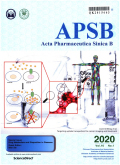- 钛学术文献服务平台 \
- 学术期刊 \
- 医药卫生期刊 \
- 药学期刊 \
- 药学学报(英文版)期刊 \
null
Hypericin enhances β-lactam antibiotics activity by inhibiting sarA expression in methicillin-resistant Staphylococcus aureus
基本信息来源于合作网站,原文需代理用户跳转至来源网站获取
摘要:
Bacteremia is a life-threating syndrome often caused by methicillin-resistant Staphylococcus aureus (MRSA).Thus,there is an urgent need to develop novel approaches to successfully treat this infection.Staphylococcal accessory regulator A (SarA),a global virulence regulator,plays a critical role in pathogenesis andβ-1actam antibiotic resistance in Staphylococcus aureus.Hypericin is believed to act as an antibiotic,antidepressant,antiviral and non-specific kinase inhibitor.In the current study,we investigated the impact of hypericin on β-1actam antibiotics susceptibility and mechanism(s) of its activity.We demonstrated that hypericin significantly decreased the minimum inhibitory concentrations of β-lactam antibiotics (e.g.,oxacillin,cefazolin and nafcillin),biofilm formation and fibronectin binding in MRSA strain JE2.In addition,hypericin significantly reduced sarA expression,and subsequently decreased mecA,and virulence-related regulators (e.g.,agr RNAⅢ) and genes (e.g.,fnbA and hla) expression in the studied MRSA strain.Importantly,the in vitro synergistic effect of hypericin with β-1actam antibiotic (e.g.,oxacillin) translated into in vivo therapeutic outcome in a murine MRSA bacteremia model.These findings suggest that hypericin plays an important role in abrogation of β-lactam resistance against MRSA through sarA inhibition,and may allow us to repurpose the use ofβ-lactam antibiotics,which are normally ineffective in the treatment of MRSA infections (e.g.,oxacillin).

推荐文章
期刊_丙丁烷TDLAS测量系统的吸收峰自动检测
带间级联激光器
调谐半导体激光吸收光谱
雾剂检漏 中红外吸收峰 洛伦兹光谱线型
不同盐度、温度及光照对漂浮浒苔生理生态的影响
浒苔
盐度
温度
光照
生理生态
期刊_联合空间信息的改进低秩稀疏矩阵分解的高光谱异常目标检测
高光谱图像
异常目标检测 低秩稀疏矩阵分解 稀疏矩阵 残差矩阵
内容分析
关键词云
关键词热度
相关文献总数
(/次)
(/年)
引文网络
引文网络
二级参考文献 (0)
共引文献 (0)
参考文献 (0)
节点文献
引证文献 (0)
同被引文献 (0)
二级引证文献 (0)
2019(0)
- 参考文献(0)
- 二级参考文献(0)
- 引证文献(0)
- 二级引证文献(0)
研究主题发展历程
节点文献
Hypericin
β-Lactams
MRSA
Synergistic effect
SarA
研究起点
研究来源
研究分支
研究去脉
引文网络交叉学科
相关学者/机构
期刊影响力
药学学报(英文版)
主办单位:
出版周期:
双月刊
ISSN:
2211-3835
CN:
10-1171/R
开本:
出版地:
北京市先农坛街1号
邮发代号:
创刊时间:
语种:
eng
出版文献量(篇)
688
总下载数(次)
0
总被引数(次)
1428
期刊文献
相关文献
推荐文献
- 期刊分类
- 期刊(年)
- 期刊(期)
- 期刊推荐

 免费查重
免费查重










